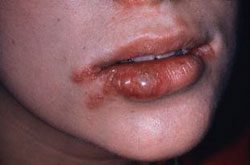Oral-Pharyngeal Candida Infection in Infants
Oral-pharyngeal Candida infections are common in newborns due to exposure to fungi from the mother during childbirth. This condition typically presents as white, opaque patches that can be removed from the soft tissues, often accompanied by inflammation and petechiae.
Diagnosis is based on direct microscopy of swabs or culture samples taken from the lesions. Oral-pharyngeal Candida albicans infections usually resolve on their own in healthy infants, but in prolonged cases, treatment with nystatin or fluconazole is recommended to expedite recovery and reduce the risk of transmission.
Oral-pharyngeal Candida infection is also a significant concern in the treatment of bone marrow failure. Systemic Candida infections can occur and may be fatal in patients undergoing treatment for bone marrow failure, particularly in those with existing oral-pharyngeal, esophageal, or intestinal Candida infections. The combined treatment of 0.2% chlorhexidine solution and fluconazole is significant in preventing oral-pharyngeal Candida infections in pediatric bone marrow transplant patients, thereby reducing the risk of systemic and esophageal Candida infections.
Aphthous Ulcers
Aphthous ulcers are specific lesions in the mouth that tend to recur. They are reported to occur in about 20% of the population, presenting as well-defined ulcers with a necrotic white base surrounded by a red inflammatory halo. These lesions typically last 10-14 days and heal spontaneously without scarring.
Herpetic Gingivostomatitis
 |
Herpes Mouth Disease (Image: dentistry) |
After an incubation period of about one week, individuals infected with the herpes virus begin to experience symptoms such as fever and fatigue. The oral cavity may show various manifestations, including swollen, red gums and small clusters of vesicles scattered throughout the mouth. These symptoms usually resolve within two weeks without leaving scars. Rehydration may be necessary if the child is dehydrated. Mouth rinses that provide pain relief and reduce fever can help make the child more comfortable.
Recurrent Herpes Labialis
Approximately 90% of individuals have antibodies against the herpes simplex virus. Unlike primary herpetic gingivostomatitis, recurrent herpetic lesions are typically localized to the lips. Besides painful vesicles and other atypical symptoms, recurrent herpes labialis usually does not present with systemic symptoms. Antiviral medications are less effective compared to soothing therapies in otherwise healthy patients experiencing recurrent herpes.
Bohn Nodules
Bohn nodules appear in newborns as congenital nodules located in the oral cavity and on the tongue, particularly on the alveolar ridges of the upper and lower jaws, and on the hard palate. These lesions are formed from remnants of the epithelial lining of the mucous glands. Bohn nodules do not require treatment and typically resolve on their own within a few weeks.
Dental Lamina Cysts
Dental lamina cysts appear in newborns as small cysts located along the alveolar ridges of the upper and lower jaws. These lesions arise from remnants of the dental lamina epithelium. Dental lamina cysts do not require treatment and usually disappear within a few weeks.
Fordyce Granules
Approximately 80% of adults have numerous small, white or yellow spots that form clusters or patches on the oral mucosa, primarily on the lips and inner cheeks. These are abnormal sebaceous glands that appear at birth, can enlarge, and may initially appear as yellowish plaques; the incidence is about 50% in children. Fordyce granules do not require treatment.
Gingival Abscess
A gingival abscess is characterized by a soft, red nodule located next to the roots of teeth affected by chronic dental abscesses. Gingival abscesses are often in locations where dental abscesses may drain pus. Treatment primarily involves accurately diagnosing the tooth causing the abscess for extraction or endodontic treatment.
Chapped Lips
Chapped lips are common in children, presenting as dry lips followed by flaking and cracking, often accompanied by a burning sensation. This condition is usually caused by allergic reactions to contact substances (toys or food) or sun exposure. It worsens when there is insufficient moisture from the tongue and further drying from wind, especially in cold weather. Chapped lips are often associated with fever. Regularly applying a thin gel can help lesions heal quickly and prevent recurrence.
Tongue-Tie
Tongue-tie is characterized by a short frenulum that restricts tongue movement. The frenulum typically elongates as the child grows. If the severity of tongue-tie impacts speech function, surgical intervention may be indicated.
Geographic Tongue
Geographic tongue is usually benign and does not have clinical significance, presenting as one or several bright red, flat patches surrounded by white, yellow, or gray borders on a normal red tongue base. The etiology remains unclear, and no treatment is needed.
Fissured Tongue
Fissured tongue is characterized by multiple small grooves or fissures on the dorsal surface of the tongue. If painful, it can be managed by scraping to clean the tongue or using mouth rinses to reduce bacterial load in the fissures.
Dr. PHAM HONG DUC




















































